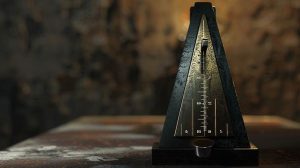
The Benefits of the Ear to Instrument Connection
I recently watched a video performance by the amazing classical pianist Yuja Chang. I’ve seen her memorizing motion and heard her virtuosic playing before, but something hit me after seeing
Categories:
Categories:
I gave a lesson this week to a piano player who wants to play jazz better. From our interaction, I was reminded of an important element of practicing that too few players consistently do.
I’m not a jazz piano specialist. I’ll leave that distinction to guys like Richie Beirach, Bert Seager, Dan Haerle, and others. I do see myself, however, as a specialist in finding relationships in things and in breaking down activities to their constituent parts.
I have a knack for getting to the root of a problem and stripping away non-essentials in order to isolate and strengthen component parts of a complex activity like improvising.
So let’s examine the idea of breaking playing down to some of its basic activities, assessing your ability in those activities, isolating what is weak, working on just that, then putting it back together and hearing the results.
This process, by the way, works well in all complicated aspects of life, but I want to give you some examples in music that may help you get better quicker. Consider this a lesson in how to learn something quicker, easier, and have more fun in the process.
Maybe I should first contrast this with the habit too many players have of just beating a task into submission. Using this method, say you have a difficult part to perform, so the way you practice it is to simply repeat it over and over and over until at some point, you seem to be able to play it well enough.

What is wrong with that method of sheer repetition? First, I don’t think it’s fun to fail over and over. Second, and more importantly, as you play the same passage over and over making no fundamental adjustments, you are reinforcing bad habits rather than discovering the aspects of your playing mechanics beneath the surface that should be strengthened before moving on.
Those more fundamental aspects of your playing probably relate to everything else you are playing, and by isolating and strengthening those lower level skills, you will find yourself more able to play other difficult passages. We call this, getting better on your instrument.
For example, in the lesson, I asked the piano player to improvise something for me at his piano, which he did. What I heard was consistently short phrases mostly beginning on beat one or at least on other downbeats, very limited dynamic range, limited note range – generally within one octave -no discernible emotion or musical story.
I could have shared what I heard and then asked him to do it again. But improvising jazz on any musical instrument is very difficult. We are coordinating and balancing many different muscle activities, we are listening to the sounds around us (hopefully!), and dealing with the thoughts going through our head as we play. That’s a complicated dance. What if we isolate one or more components of that process and focus on just one or at least a few less than the entire process?
I asked him to play again, this time with only his right hand. In other words, isolate the right hand by removing the left hand comping from the process. I could tell that his left hand was getting in the way of his improvising.
Doing as I asked, what he played next sounded like a completely different piano player. Longer phrases, much wider range of articulations and dynamics, and much more musical. What we did was simplify the activity of improvising by removing one component – his left hand.
We know that one handed playing is not the end goal of a jazz pianist, so take a second to think about what you might recommend he do to reintroduce his left hand which was struggling with comping and distracting his right hand improvisation?
The tune he played was already at a pretty slow tempo so slowing it down wouldn’t be my first thought, although removing a faster tempo is a common way to simplify. – slowing down a passage is a common and useful first step which I’ll demonstrate in part two.
There is no one correct answer, but how about simply playing roots with the left hand while improvising with the right. Even if they are not lower register roots, play just one note-the chord root.
Doing that, what if those single left hand notes again distracted his right hand improvisation? Then play just those roots alone to confirm that he knows them without too much or any thinking. And this is a case where speeding things up is beneficial. How fast can he play those singe note roots? Playing things with exaggerated speed makes it more difficult to think your way through. Remember, that left hand comping needs to be driven by the subconscious.
Once the right hand can improvise as freely with those left hand roots as it did by itself, what might be the next step? How about working just on the left hand comping? But how? Start by comping with the left hand only, slower tempo gradually making its way to faster, and then to much faster. Do it without thinking, and just by hearing the flow. This is where repetition pays off, once you’ve identified the basic skill needing to be exercised.
By the way, concerning repetition, avoid the habit of always starting at the beginning of something you are working on, whether it is the playing roots, comping, or the full practice performance. In this case, this student was struggling more with the bridge, so he should mix things up by occasionally starting on the bridge, or half-way through the bridge. If you really know a tune, you can start anywhere, not just at the top.
Next, how about singing an improvisation while comping with the left hand? If that throws the left hand comping off, you haven’t yet mastered the comping well enough. Go back and continue the left hand-only work. Perhaps as an intermediate step, go back to playing left hand roots but this time while singing an improvisation.
Playing any instrument requires coordination of multiple activities. That’s part of what makes it so difficult. Get good at isolating various components of your playing, removing some, and drilling on others. Mastering that skill will help you more quickly become a better player, regardless of your instrument.
In part two, I will demonstrate this further by breaking down a difficult solo transcription on trombone.

Trombonist, author, marketer, & tech guy
Share this post…

I recently watched a video performance by the amazing classical pianist Yuja Chang. I’ve seen her memorizing motion and heard her virtuosic playing before, but something hit me after seeing

I have created a AI chatbot called Jazz Master Chat that draws from 75 hours of interviews from my Jazz Master Summit event a couple of years ago. I interviewed

What is jazz improvisation? Let’s first define what I mean by jazz improvisation. Jazz improvisation is a spontaneous conversation, but instead of words, we use notes. Look at two possible

My recently turned 18 year old son is a passionate photographer He 8217 s got himself a little business

A couple weeks ago I sent Richie Beirach a YouTube clip from the movie Whiplash as a bit of

I originally meant to write this as a reply to a comment Richie Beirach wrote on my blog But

Tools for helping musicians at all levels learn about jazz and play to their full capability.
Web design and marketing by:
Michael Lake @JazzDigitalMarketing.com
This is just a fake book example for the type of website I can build for you. Just trying to use a little humor here!
2 thoughts on “Practice this way to improve your skills quicker – Part 1”
Good info Michael! Thanks
I like it. I have practiced this way on guitar and it helps. My problem now is that I am working on a duo project and my partner’s musical knowledge is extremely limited. He has played strictly by feel and getting things wrong most of the time. He has a lot to learn and he doesn’t appear to be applying himself well enough yet. Patience! It’s a challenge to get a student to apply themselves sufficiently. Sometimes they think that they are just buying the ability to play music. Thanks for you clear thinking and good tips. (from a veteran player).